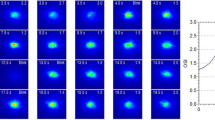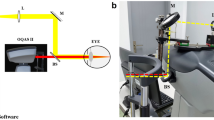Abstract
Purpose
To investigate the relation of functional visual acuity (FVA) measurements with dry eye test parameters and to compare the testing methods with and without blink suppression and anesthetic instillation.
Design
A prospective comparative case series.
Methods
Thirty right eyes of 30 dry eye patients and 25 right eyes of 25 normal subjects seen at Keio University School of Medicine, Department of Ophthalmology were studied. FVA testing was performed using a FVA measurement system with two different approaches, one in which measurements were made under natural blinking conditions without topical anesthesia (FVA-N) and the other in which the measurements were made under the blink suppression condition with topical anesthetic eye drops (FVA-BS). Tear function examinations, such as the Schirmer test, tear film break-up time, and fluorescein and Rose Bengal vital staining as ocular surface evaluation, were performed.
Results
The mean logMAR FVA-N scores and logMAR Landolt visual acuity scores were significantly lower in the dry eye subjects than in the healthy controls (p < 0.05), while there were no statistical differences between the logMAR FVA-BS scores of the dry eye subjects and those of the healthy controls. There was a significant correlation between the logMAR Landolt visual acuities and the logMAR FVA-N and logMAR FVA-BS scores. The FVA-N scores correlated significantly with tear quantities, tear stability and, especially, the ocular surface vital staining scores.
Conclusions
FVA measurements performed under natural blinking significantly reflected the tear functions and ocular surface status of the eye and would appear to be a reliable method of FVA testing. FVA measurement is also an accurate predictor of dry eye status.




Similar content being viewed by others
References
The 2007 Dry Eye Workshop Epidemiology Subcommittee. The epidemiology of dry eye disease: report of the epidemiology subcommittee of the international dry eye workshop. Ocul Surf. 2007;5:93–107.
Jinda LF, Zemon V. Contrast sensitivity testing: a more complete assessment of vision. J Cataract Refract Surg. 1989;15:141–8.
Owsley C, Slone ME. Contrast sensitivity acuity, and the perception of ‘real world’ targets. Br J Ophthalmol. 1987;71:791–6.
Abrahamsson M, Sjostrand J. Impairment of contrast sensitivity function (CSF) as a measure of disability glare. Invest Ophthalmol Vis Sci. 1986;27:1131–6.
Rolando M, Iester M, Macrí A, Calabria G. Low spatial-contrast sensitivity in dry eyes. Cornea. 1998;17:376–9.
Huang FC, Tseng SH, Shih MH, Chen FK. Effect of artificial tears on corneal surface regularity, contrast sensitivity, and glare disability in dry eyes. Ophthalmol. 2002;109:1934–40.
Puell MC, Benítez-del-Castillo JM, Martínez-de-la-Casa J, Sánchez-Ramos C, Vico E, Pérez-Carrasco MJ, et al. Contrast sensitivity and disability glare in patients with dry eye. Acta Ophthalmol Scand. 2006;84:527–31.
Rieger G. The importance of the precorneal tear film for the quality of optical imaging. Br J Ophthalmol. 1992;76:157–8.
Liu Z, Pflugfelder SC. Corneal surface regularity and the effect of artificial tears in aqueous tear deficiency. Ophthalmology. 1999;106:939–43.
Bron AJ, Tiffany JM, Gouveia SM, Yokoi N, Voon LW. Functional aspects of the tear film lipid layer. Exp Eye Res. 2004;78:347–60.
Kojima T, Ishida R, Dogru M, Goto E, Takano Y, Matsumoto Y, et al. A new noninvasive tear stability analysis system for the assessment of dry eyes. Invest Ophthalmol Vis Sci. 2004;45:1369–74.
Yokoi N, Yamada H, Mizukusa Y, Bron AJ, Tiffany JM, Kato T, Kinoshita S. Rheology of tear film lipid layer spread in normal and aqueous tear deficient dry eyes. Invest Ophthalmol Vis Sci. 2008;49:5319–24.
Ozkan Y, Bozkurt B, Gedik S, Irkeç M, Orhan M. Corneal topography study of the effect of lacrimal punctum occlusion on corneal surface regularity in dry eye patients. Eur J Ophthalmol. 2001;11:116–9.
Goto E, Yagi Y, Matsumoto Y, Tsubota K. Impaired functional visual acuity of dry eye patients. Am J Ophthalmol. 2002;133:181–6.
Koh S, Maeda N, Hirohara Y, Mihashi T, Bessho K, Hori Y, et al. Serial measurements of high-order aberrations after blinking in patients with dry eye. Invest Ophthalmol Vis Sci. 2008;49:133–8.
Goto E, Yagi Y, Kaido M, Matsumoto Y, Konomi K, Tsubota K. Improved functional visual acuity after punctal occlusion in dry eye patients. Am J Ophthalmol. 2003;135:704–5.
Ishida R, Kojima T, Dogru M, Kaido M, Matsumoto Y, Tanaka M, et al. The application of a new continuous functional visual acuity measurement system in dry eye syndrome. Am J Opthalmol. 2005;139:253–8.
Kaido M, Goto E, Dogru M, Tsubota K. Punctal occlusion in the management of chronic Stevens Johnson syndrome. Ophthalmology. 2004;111:895–900.
Kaido M, Ishida R, Dogru M, Tamaoki T, Tsubota K. Efficacy of punctum plug treatment in short break-up time dry eye. Optom Vis Sci. 2008;85:758–63.
Shimazaki J. Definition and diagnosis of dry eye 2006 (in Japanese). J Eye. 2007;24:181–4.
van Bijsterveld OP. Diagnostic tests in the Sicca syndrome. Arch Ophthalmol. 1969;82:10–4.
Tsubota K, Hata S, Okusawa Y, Egami F, Ohtsuki T, Nakamori K. Quantitative videographic analysis of blinking in normal subjects and patients with dry eye. Arch Ophthalmol. 1996;114:715–20.
Conflict of interest
The authors have no financial conflict of interest. Drs. Kazuo Tsubota and Minako Kaido hold patent rights for the method and the apparatus for the measurement of functional visual acuity (US patent no: 7470026).
Author information
Authors and Affiliations
Corresponding author
Additional information
An earlier version of this study was presented at the 60 Annual Congress of Clinical Ophthalmology, Kyoto, Japan
About this article
Cite this article
Kaido, M., Ishida, R., Dogru, M. et al. The relation of functional visual acuity measurement methodology to tear functions and ocular surface status. Jpn J Ophthalmol 55, 451–459 (2011). https://doi.org/10.1007/s10384-011-0049-8
Received:
Accepted:
Published:
Issue Date:
DOI: https://doi.org/10.1007/s10384-011-0049-8




